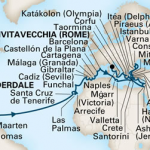
This week, we pose a question: Are you a big-ship cruiser or a small-ship cruiser?
You’ll find a lot of discussion here about big and small ships, but I encourage you to weigh in with your opinions. Do you prefer the activities and thrills of big ships? Or are you more for the quieter environments of small ships?
I am a bit of both, but while I enjoy the big-ship experience, I find myself drawn to smaller ships for at least five reasons:
- Small ships = No crowds. When cruising on small ships, you’ll almost always experience less crowding on ship and ashore than you will on large ships. Small ships typically have the highest space ratios per passenger, which we discuss below, and avoid crowding at ports. Yesterday, in Akaroa, New Zealand, for example, Silver Shadow was the only ship in sight. The day before, however, two ships called, including one enormous one, disgorging a few thousand passengers into a town of only 700. Crowding in ports can be greatly exaggerated in the Caribbean.
- Small ships typically are roomier. I’m not claustrophobic, but I do like space, both in the public rooms on ships and in staterooms. Last year, I was on a big (very big) ship with my two kids. We would have ordered room service for dinner one night, but as my daughter pointed out, “There was no room for service.” By contrast, staterooms and public areas on small ships almost always have higher space ratios (a figure derived by dividing capacity by cubic feet) and staterooms with more square footage than those on big ships. Small ships give you space to breathe.
- Small ships visit off-the-beaten-track destinations. Big ships don’t call on such idyllic islands as Bequia or Jost Van Dyke.
- You get to know your fellow passengers on small ships. On a big ship, you can meet folks and never see them again. Not likely on small ships, where there may be fewer than a couple of hundred others cruising with you. There is an anonymity factor on big ships that isn’t present on small ships. Staff greet you by name. I’ve cruised on nearly all of the small-ship cruise lines listed below, and on all, waiters, bartenders, pool stewards and officers greet me and other passengers by name. Moreover, you also get to know — and want to get to know — the staff. Most whom I have met are outstanding people. I have seen passengers hugging staff, sometimes tearfully, upon parting. And while it sounds clichéd, cruise travelers make lifelong friends with their fellow travelers. The overall experience on small ships is simply more intimate than what you would find on big ships.
- Small ships generally offer a better quality travel experience. I realize this is highly subjective, but the quality of accommodation, the quality of the food, the quality of the overall travel experience, including the on-shore experiences, is nearly always superior on a small ship. Big ships are doing great work in all of these areas, and sometimes, food and service, particularly at the specialty restaurants on big ships, can rival the offerings of the small ships, but in general, smaller ships offer richer travel experiences than big ships, which typically offer theme-park (think Disney Cruise Line) and resort-style experiences.
What makes a small ship? There are lots of variables and lots of opinions, but I characterize cruise ships carrying fewer than 1,000 passengers as small. After all, 1,000 passengers is less than 20 percent of the total capacity of the world’s largest cruise ships. Smaller is bigger than it used to be.
Which companies operate small ships?
- Azamara Club Cruises
- Crystal Cruises
- Lindblad Expeditions
- Oceania Cruises
- Paul Gauguin
- Regent Seven Seas Cruises
- Seabourn
- SeaDream Yacht Club
- Silversea Cruises
- Star Clippers
- Windstar Cruises
- Zegrahm Expeditions
- And all river cruise companies
Also, some big ship operators have smaller ships in their fleets, including Celebrity Cruises’ Xpedition, Holland America Line’s Prinsendam and Princess Cruises’ Pacific Princess and Ocean Princess, which carry fewer than 900 guests and visit smaller ports but are not all-inclusive.
Cost of small-ship cruising. The cost of small-ship cruising is often double or more what it would cost to cruise on a large ship, but small ships can provide greater value. Beverages, including specialty coffees, soft drinks, fine wines, champagne, beer and spirits, and gratuities often are included in the cruise fare. Plus, there are many other intangibles, such as those five things mentioned above, that add to the overall value.
What about you? Are you a big-ship cruiser or a small-ship cruiser?




 Donna Hull says
Donna Hull says
February 2, 2012 at 7:48 amI have almost 300 nights on small ship cruises. I guess you could call me a fan.Your point that they offer more value is very true. Small ships are especially appealing to baby boomer cruisers who have the time to take some of the longer itineraries.
 Alysia Murillo says
Alysia Murillo says
February 2, 2012 at 12:39 pmThanks for your input Donna. Your point on baby boomers having the opportunity to take something other than a 7 day is very true!